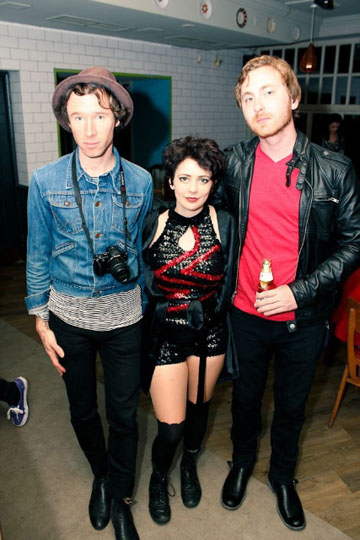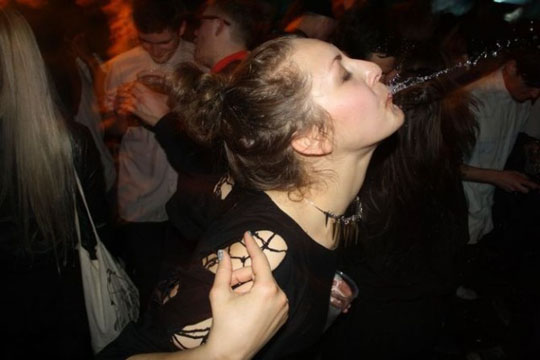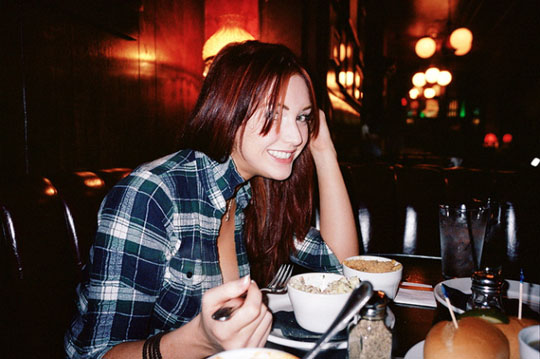
| This first image shows three 'party goers' from the launch of their new issue in Bristol, England. The photo operates as a 'demand' (Rose, 114), meaning that the subjects are looking right us, thus commanding the viewer to relate to them. The three of them appear to be about the same age; perhaps late-20's, all of them are white. They are wearing black and have similar footwear. These similarities communicate a particular cohesion in fashion and culture (they are attending the same event after all). They are also not smiling, thus making their appearance to the viewer a bit intimidating. Certain 'props' that are present in the photo also ad to its overall discursive message. The man on the left has a camera draped around his neck. From this we know that he is either a photographer or wishes to document the event in some way. Also, this camera codes photography within the accepted culture of Vice: we now know that photography is deemed an appropriate activity. The use of photography to document internal Vice events can be described as 'autoethnography,' which fan-theorist Matt Hills uses to describe a particular self-reflexivity within fan culture (Hills, 81). By photographing themselves Vice employees destroy the boundary between the magazine as an institution and subject. By people documenting their own lifestyle or their live events in ethnography, (photography can be thought of as an ethnographic technique), then the ethnographers "unsettle moral dualisms" and utilize a particular "common sense" based on an individual's subjectivity (Hills, 81). This technique is identity-constructing and goes against the normal modes of academic analysis within cultural studies. Therefore, by taking Hill's concept into action, the candid photographs occupy a space that disrupts the traditional relationship between ethnographer (photographer) and subject. In terms of discourse and identity, this method could also have the potential to present an even stronger cultural image to the viewer as it intends to show not what Vice 'wants us to see' but what Vice 'is.' Whether or not this is accurate (the camera only allows us to see what it wants even at a party), there could be the potential for greater power within these images. The other prop in this photograph is the beer, which reinforces that they commonly engage in a carefree party lifestyle. From this photo we have learned of a particular fashion sense, that photography is valued, beer drinking is encouraged and smiling has the potential to destroy the careful creation of the authentic alt. |  |
 |
The next photo was taken at an issue launch in London. This photo has a different feel from the first. It is less serious and reinforces a different set of subculture values. The woman is spitting what appears to he water in to the air. She is less polished and manicured than the first three partygoers and is presented as more unaware of the camera's presence. Her clothing seems less fashionable than the others, but possesses a similar alternative style. The subject's act of spitting can be thought of as rebellious or subversive, even within a party environment. This almost 'masculinized' act can be contextualized within the role of women in subculture. It is often thought that Western subculture has been historically masculine in nature (McRobbie, 40). The aggressive fashion, music and risky lifestyles associated with subcultures have been shown to marginalize both women and people of color, thus creating social spaces dominated by white (often middle-class) men (McRobbie, 41). However, the essence of subculture is a disaffiliation with hegemonic authority thus providing the possibility for transgression within gender boundaries. To furthur complicate the claim of a phallocentric counter-culture, one could argue that an adoption of a masculine-coded act provides the possibility to reinvent femininity through a Foucauldian form of productive power (McHoul, 15). In other words, the subject of this picture is contributing to a discourse that exists outside normative femininity, even if the motivation for this is to aquire a particular type of masculinized identity. That being said, it seems that the acts of social defiance as realized by the majority of Western subcultures posess a masculine backbone (McRobbie, 42) (Roszak, 58). The pressure for girls or women within a subculture is to then assimilate to the testosterone-fuelled rebellion of the counter-culture (McRobbie, 43). Male dominance within subculture is exemplified by the American punk rock movement whose aggressively male structures of authenticity motivated women create a smaller sub-culture in the 1990s (McRobbie, 139). When considering this image within the context of Vice's culture as a whole, the theory of a masculinzed discourse within the alternative 'brand' is convincing. |
